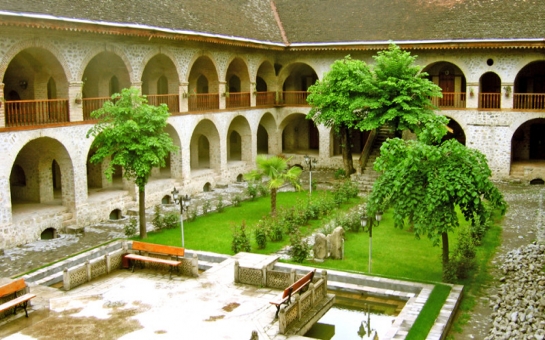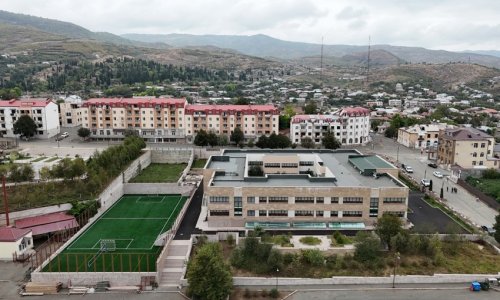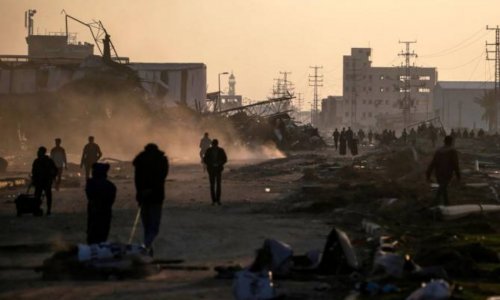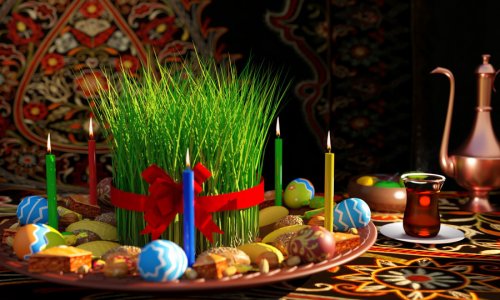By: TARA ISABELLA BURTON
It's evening at the caravansery. Businessmen gather in the garden, summoning skewers of meat, each larger than the last, to their tables. Some head indoors to the chaikhana in one of the building's converted stables, although at this hour they seek shisha (flavored tobacco), not tea. The waiters—garcons, they call themselves here—pour more wine, racing from booth to booth with desperate deference as the orders pile up.
Once, the caravanseries of Sheki, Azerbaijan's medieval capital of commerce, were filled with Silk Road merchants: traders who came with camels and spices, ceramics and silks, ferrying their products between China and Constantinople. The animals slept in the high-arched stone rooms below, the traders in smaller chambers above. The courtyard layout ensured safety—only one animal at a time could enter or exit the caravansery complex—and fostered trade. Deals were common. Exchanges of goods and gossip, languages and technology all took place in caravanseries like these.
Today, however, the merchants wear suits and conduct business on mobile phones. Languages spoken here include English, Slovak, Russian, and Polish. The caravansery—the only one of Sheki's five historic caravanseries still standing—is better known to readers of Lonely Planet than to modern-day transporters of spice.
Azerbaijan is increasingly looking to its cosmopolitan past to define its identity as a tourist destination. This summer, Azerbaijan—along with three other Turkic states—launched an initiative to develop a Silk Road tourism route across Central Asia.
Sheki holds fast to its Silk Road legacy. The city—like Azerbaijan as a whole—takes pains to emphasize its history as a onetime gateway to the East. On the winding streets of Sheki's old town, hundreds of stalls called duqans sell silk scarves and handicrafts—patterned silver dishes and intricately whittled wood. Halvesi—sweet shops—are almost as numerous, hawking halva, Sheki's best-known specialty, along with candied hazelnuts and the brightly dyed pink and yellow sugar cubes that are so ubiquitous here.
Then there's the Palace of the Sheki Khan, located high on a sweeping green hill overlooking the old town. Built in the late 18th century—without a single nail or drop of glue, according to legend—this summer residence of Sheki's onetime rulers is a wild cacophony of colors and cultures designed to showcase the Khan's power. The main visiting hall features delicately painted murals of weaponry and military banners, hunting parties and dragons—the latter a motif heavily influenced by Azerbaijan's trade with China. Ottoman fireplaces cast shadows on stained-glass windows. Once, this hall was designed to intimidate visitors, to make them fully aware of the Sheki Khan's wealth and strength. Even today, it demands reverence.
Outside, an old man keeps a taxidermied wolf hidden underneath a carpet; only its muzzle pokes out from beneath the tassels. He stretches out his hand and waits for a tourist to trickle in coins before yanking back the covering to reveal the full animal, its eyes beady, its mouth lolling open.
At New Bazaar, a labyrinth of corrugated tin at the very edge of town, Sheki's mercantile past feels even more present. Less picturesque than the elegant shopping stalls of the old town, Sheki's bazaar is a riot of colors and smells. Heads of sheep and cows, freshly severed, share table space with ladles full of sumac and coriander. Sticky halva sells for four manat (about $6) a pound. Shopkeepers, their hands glistening with honey, force free samples into my palms. It takes several napkins to get the last of the sugar off my fingertips.
I stop by one more prosaic stall to pick up a miniature screwdriver to open my cellphone. I ask the price in halting Russian; the seller grins and shrugs. It's a present, he says.
If the winding streets of Sheki embody Azerbaijan's Silk Road past, Baku, Azerbaijan's capital on the Caspian, exemplifies the city's future. Silk and spice first gave way to oil at the turn of the 19th century, Baku's initial oil boom. In 2005, with the inauguration of an Azerbaijan-Georgia-Turkey pipeline, the city boomed anew while the upper echelons of its wealth—most of whom belong to the ruling Aliyev family—sought to remold the city as a “Paris of the East.”
Such frenetic remodeling is evidenced throughout Baku's historic center. At the 15th-century palace of the Shirvanshahs, once Baku's rulers, a high-tech video display is projected onto the faded domes, offering visitors examples of how the ceilings might once have been painted. With the aid of technology, wall miniatures move and the throne room is restored. At the nearby Maiden's Tower, one of Baku's most famous landmarks, a holographic flame allows tourists to pose for fiery photographs. In the distance stands Baku's most iconic new building: three flame-shaped towers—a nod to Azerbaijan's Zoroastrian legacy—comprising offices, hotels, and apartments for the city's oil-rich elite.
At night, more holographs display neon fire as well as the Azeri flag. Along the Beaux-Arts waterfront of Neftchiler (Oilworkers) Avenue, the usual suspects proffer international luxury—Dior, Tiffany, Dolce & Gabbana—adapted to the local audience. Advertisements feature three generations of a smiling, prosperous Azeri family in a traditional-looking house. Their toddler sons wear exquisitely tailored suits. A sign for Pastis, either a franchise or knockoff of the New York restaurant, promises more decadence next door. Coffee here goes for five manat ($8) a cup.
Everything is the kind of beautiful that costs millions to construct and millions more to render subtle. The smell of oil is thick in the air.
Tonight, the caravanseries of the old town are empty. Black-suited men have cleared them out. They talk in hurried tones onto walkie-talkies. Security staff crowd the narrow alleyways.
"It's normal," says my friend Adnur, "whenever important people come into this part of town, they close it off." Tonight, it's the visiting French president; last week it was someone else. Yesterday, Adnur tells me, it was the birthday of current president Ibrahim Aliyev's late father, Heydar Aliyev, effective ruler of Azerbaijan for nearly all of its recent history, whose face still appears on billboards in every town. "You couldn't get close to the waterfront, there were so many people celebrating."
It's too expensive to get tea here, he sighs. He takes me 10 minutes outside the city center, where the shining facades and historic reproductions give way to ivy, crumbling concrete, and tea brewed in rusty samovars. "People live here," he says.
But others are more excited about Baku's frenetic development. When I visit the Carpet Museum, located in a faded neoclassical building on the waterfront Bulvar, my guide, Ramaz, excitedly shows me the plans for a new museum, which he tells me will be finished in a month or two. Fashioned of chrome and glass, the new museum resembles a rolled-up carpet. He points out another new carpet: a larger-than-life photorealistic image of Heydar Aliyev. "Every thread by hand," he tells me.
Ramaz shows me the other carpets and explains how each fits into Azerbaijan's legacy of trade and cultural expansion. The cross, symbolizing the four elements, is imported from Persia and Zoroastrian religious traditions. The dragon, stylized by Sunni Muslim tradition (which prohibits lifelike depiction) into an unrecognizable "S" shape, is taken from China, Azerbaijan's frequent trading partner in the Silk Road days. Every strand tells a story and is an "exchange of spiritual values," the plaque says.
Outside, the boulevard whirs with the sound of cars and the smell of oil seeps out to sea.
Bakudaily.Az











